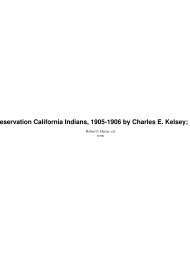Spring 2008 - Yosemite Conservancy
Spring 2008 - Yosemite Conservancy
Spring 2008 - Yosemite Conservancy
- No tags were found...
You also want an ePaper? Increase the reach of your titles
YUMPU automatically turns print PDFs into web optimized ePapers that Google loves.
used as tinder. Burning sticks and pine cones were used<br />
to spread the fire through the burn unit instead of a mixture<br />
of diesel and gasoline in a drip torch. This manner of<br />
ignition also kept hydrocarbon contaminants out of the<br />
wetland.<br />
The National Park Service made a short film documenting<br />
the cooperation involved in arranging and<br />
conducting the burn and its subsequent ecological and<br />
cultural effects. This video has been used to educate the<br />
public, park staff and researchers, illustrating the positive<br />
effects of this cooperation.<br />
Ultimately, the project reduced accumulated fuels<br />
in the form of thatch and litter, and killed many of the<br />
encroaching conifers. The burn also reduced the chance<br />
of a catastrophic fire in <strong>Yosemite</strong> Valley and increased the<br />
Park Service’s ability to control unwanted fires. As part<br />
of a mosaic of Valley burns of differing ages, the meadow<br />
will act as a fuel break to slow the spread of unwanted<br />
wildfires, and increase the health of surviving native<br />
vegetation by reducing competition for water, nutrients<br />
and sunlight. Opening up the meadow is a step towards<br />
restoring historic viewsheds and the character of the<br />
historic landscape which drew Euro-American visitors to<br />
<strong>Yosemite</strong> in the first place.<br />
The prescribed burn also diminished patches of<br />
invasive blackberry, permitting ongoing management<br />
with mechanical thinning. Pulling sprouts after burning<br />
affords several advantages, including improved visibility<br />
of the root and less need to pile and burn cut brambles.<br />
The 2006 data from the research plots suggests that<br />
mechanical removal and fire resulted in more native and<br />
non-native plant species than burning alone. While the<br />
increase of non-native plant cover is of concern, the species<br />
present are easier to control than blackberry. Finally,<br />
plants that were identified as traditionally important have<br />
been rebounding. Data gathered in subsequent years will<br />
add to our understanding of how resources were traditionally<br />
managed, and how these techniques may be integrated<br />
with current management practices.<br />
Other aspects of burn success were harder to measure<br />
but are equally important to recognize. The project leaders<br />
hope that the project succeeded in honoring the traditions<br />
and history of the American Indians. One tribal<br />
elder, a retired NPS employee who served as burn boss<br />
on some of the earliest prescribed fires in <strong>Yosemite</strong> Valley,<br />
found it rewarding to burn again in <strong>Yosemite</strong> Valley, this<br />
time as a continuation of traditional cultural practices.<br />
Fire Management personnel got to participate in traditional<br />
fire management practices, and proposed that the<br />
park attempt to include some form of these traditional<br />
practices each fire season. Meanwhile, the Park Service<br />
will continue to document the burn’s long-term impacts<br />
on the health of the meadow and the return of traditionally<br />
important plants. As part of scheduled restoration,<br />
BRENT JOHNSON, NPS (3)<br />
the restrooms and part of the road to the defunct campground<br />
were removed shortly after the burn. It is hoped<br />
that the removal of this infrastructure will allow a more<br />
natural hydrology to return to the meadow. Finally, the<br />
cooperation and contributions of all involved instilled<br />
the hope that the sometimes daunting mission of the<br />
National Park Service can be fulfilled one small meadow<br />
at a time.<br />
Jun Kinoshita is the Park Fire Archeologist and works<br />
in the Branch of Anthropology and Archeology in the<br />
Division of Resources Management and Science for the<br />
National Park Service.<br />
Careful planning and a fuel break prevent the prescribed burn<br />
from spreading farther than desired.<br />
YOSEMITE ASSOCIATION, SPRING <strong>2008</strong><br />
9




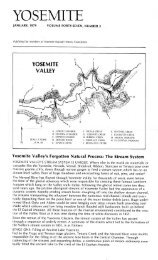
![(March 1982) [PDF] “We Are Pleased to Announce†- Yosemite Online](https://img.yumpu.com/51299748/1/190x242/march-1982-pdf-aeuroewe-are-pleased-to-announceaeur-yosemite-online.jpg?quality=85)
![[PDF] Old Horny, Yosemite's Unicorn Buck - Yosemite Online](https://img.yumpu.com/51269869/1/184x260/pdf-old-horny-yosemites-unicorn-buck-yosemite-online.jpg?quality=85)
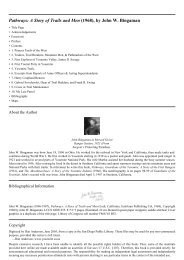
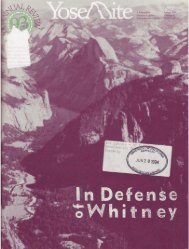
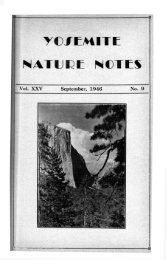
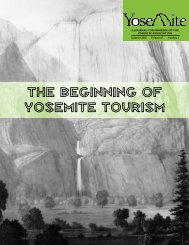
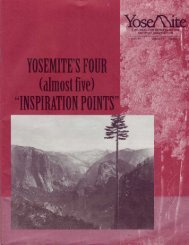
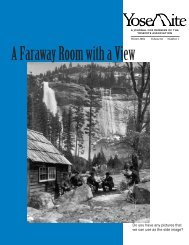
![1985 [PDF] - Yosemite](https://img.yumpu.com/48128837/1/184x260/1985-pdf-yosemite.jpg?quality=85)

